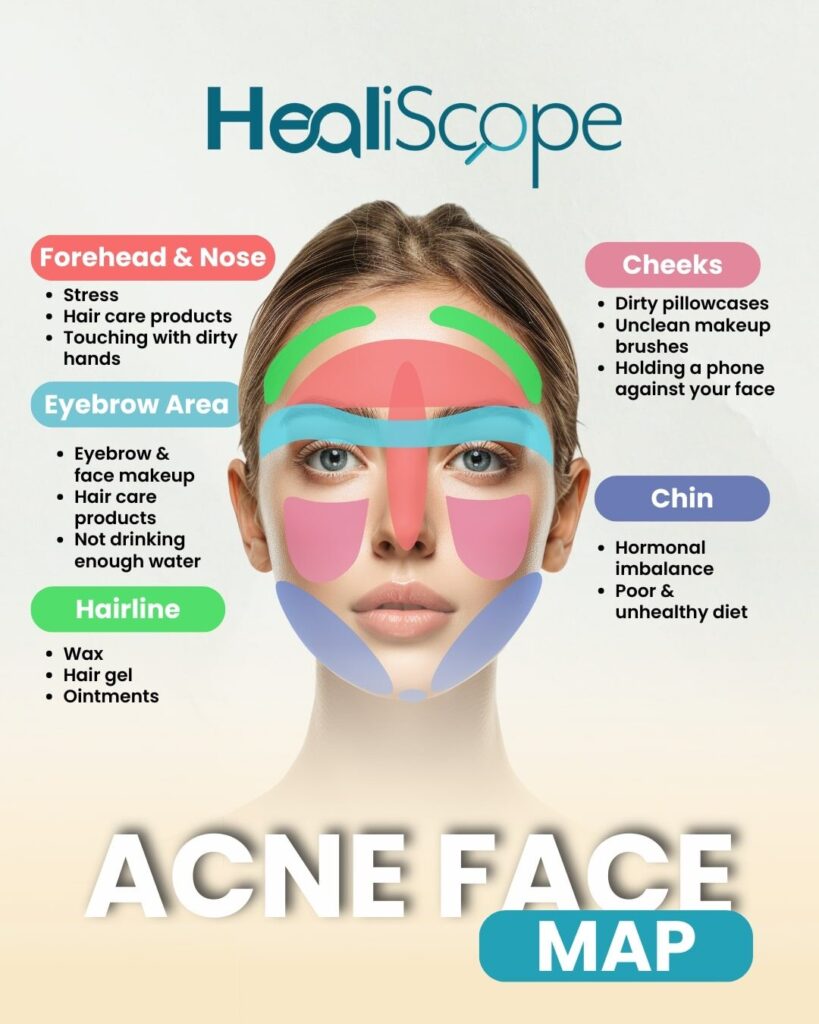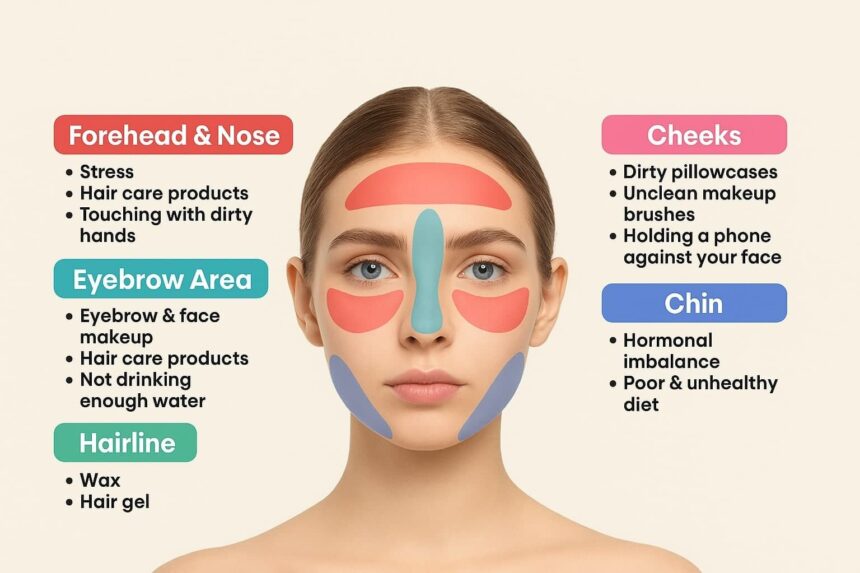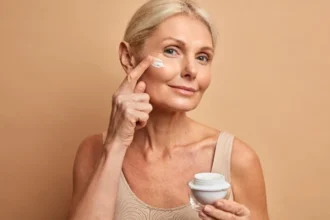You’re breaking out—again—and it’s always in the same places: your forehead, nose, cheeks, or chin. Sound familiar?
Most people blame hormones or stress, but what if your acne is trying to tell you something more specific?
The acne pimple face map is a tool that connects the location of your breakouts to potential internal or external triggers. While not a diagnostic method, this approach can help you spot patterns, adjust habits, and improve your skin health with more intention.
In this evidence-informed guide, we’ll walk through what each acne zone might reveal about your body—and how to respond with smarter skincare choices.
What Is an Acne Face Map?
An acne face map is a visual framework that links the location of breakouts to potential underlying causes—internal imbalances, lifestyle habits, or environmental factors. The concept has its roots in ancient systems like Traditional Chinese Medicine and Ayurveda, where different facial zones are believed to correspond with specific organs and functions in the body.
While modern dermatology doesn’t formally recognize face mapping as a diagnostic method, many professionals acknowledge that acne patterns can reflect deeper trends—like hormonal shifts, digestive stress, or external irritants. It’s not an exact science, but it can help guide your skincare strategy by bringing attention to where acne appears most frequently.
⚠️ Important: Face mapping should not replace medical advice. If you experience chronic, painful, or cystic acne, it’s best to consult a board-certified dermatologist for proper evaluation and treatment.
Acne Map Breakdown: What Each Zone Might Mean
Your skin might be telling you more than you think, especially when breakouts consistently show up in the same areas. Here’s the acne pimple face map, what each facial zone could be signaling and how to respond with smarter habits and skincare.

1. Forehead & Nose (T-Zone)
Breakouts on the forehead and nose are typically linked to excess oil production, which makes this area a common acne hotspot. Stress, buildup from hair care products, and touching your face with unclean hands can all clog pores here.
Some face mapping traditions also associate forehead acne with digestive stress and irregular sleep.
✅ What you can do:
- Keep your bangs clean and off your forehead
- Wash pillowcases frequently
- Use a gentle double cleanse routine
- Limit processed foods and consider taking probiotics for gut balance
2. Eyebrow Area
If you’re noticing pimples between or around your brows, your makeup or hair products might be to blame. Brow pencils, waxes, or gels often leave behind pore-clogging residue. Additionally, dehydration may contribute to buildup in this area.
In traditional systems, this zone is loosely linked to liver health.
✅ What you can do:
- Fully remove brow and face makeup every evening
- Switch to non-comedogenic hair styling products
- Limit alcohol and drink plenty of water daily
3. Cheeks
Breakouts on the cheeks are often caused by external irritation—specifically, contact with bacteria-laden surfaces. Dirty pillowcases, unclean cell phones, and makeup brushes can all transfer oil, dirt, and bacteria to this sensitive area.
✅ What you can do:
- Wash pillowcases and bed linens at least once a week
- Regularly sanitize your phone screen with alcohol wipes
- Replace or deep-clean your makeup brushes every three months
4. Chin & Jawline
Persistent acne along the chin and jawline is strongly linked to hormonal fluctuations, especially in adult women. Breakouts in this area often worsen around the menstrual cycle and can signal increased androgen (testosterone) activity.
✅ What you can do:
- Track breakouts in relation to your cycle to spot patterns
- Discuss persistent jawline acne with a dermatologist; hormonal treatments like spironolactone may be recommended in some cases
5. Hairline
Acne near the hairline is often caused by heavy hair products such as waxes, pomades, and edge control gels. These products can clog pores around the forehead and temples, leading to what’s commonly called “pomade acne.”
✅ What you can do:
- Switch to non-comedogenic (pore-friendly) hair products
- Avoid applying styling products too close to the skin
- Pull hair away from the face during workouts and sleep to reduce friction and sweat buildup
Is Acne Face Mapping Scientifically Proven?
The short answer: not fully.
While the concept of acne pimple face map is popular, it is not formally recognized as a diagnostic method in evidence-based dermatology. Some research suggests that the distribution patterns of acne—such as breakouts along the jawline being linked to hormonal fluctuations—may offer useful clinical clues (supported by dermatological studies on adult acne patterns).
However, leading institutions like the Cleveland Clinic and Mayo Clinic emphasize that acne is a multifactorial condition, influenced by genetics, hormones, lifestyle, and environmental factors. This complexity makes it difficult to reliably diagnose internal health issues based solely on breakout locations.
Professional dermatological resources, including guidelines summarized by DermNet NZ, also caution against overinterpreting face mapping. While it can serve as a self-awareness tool, it should not replace professional medical evaluation.
🔔 Clinical Note:
Persistent, painful, or cystic acne requires assessment by a board-certified dermatologist to rule out underlying medical conditions and to ensure proper treatment.
How to Build a Skincare Routine Based on Your Breakout Zones
If you notice that acne tends to cluster in certain areas, you can fine-tune your skincare routine based on your personal face map.
✅ Steps to Create a Targeted Routine:
- Track your patterns: Keep a skincare journal noting where and when breakouts occur.
- Adapt your routine: Choose cleansers, serums, and treatments that address the specific needs of oily zones, dry patches, or hormonal areas.
- Use non-comedogenic products: Always check that moisturizers, sunscreens, and makeup are labeled “non-comedogenic” to avoid clogged pores.
- Know when to seek help: If breakouts persist despite adjusting your routine, it may be time to consult a dermatologist for personalized treatment options.
Building a routine that listens to your skin—not just follows trends—can make a major difference over time.
Frequently Asked Questions (FAQ)
Is face mapping for acne accurate?
Face mapping is not considered an exact science in clinical dermatology. However, it can sometimes offer useful insights. Some dermatologists acknowledge that the location of acne breakouts may reflect patterns related to hormonal shifts, dietary habits, or environmental exposures.
Why do I always get pimples in the same spot?
Recurring breakouts in the same area often suggest a persistent trigger. Factors like hormonal cycles, friction from pillowcases, improper skincare routines, or buildup from hair and cosmetic products commonly contribute to localized acne patterns.
Can stress cause forehead acne?
Yes, chronic stress can significantly impact skin health. Elevated cortisol levels stimulate oil production in sebaceous glands, which increases the likelihood of clogged pores and breakouts, especially in the forehead area, often referred to as the “T-zone.”
What does chin acne mean hormonally?
Chin and jawline acne is frequently associated with hormonal fluctuations, particularly related to androgen activity. This type of breakout is common in adult women and often intensifies around the menstrual cycle or during periods of hormonal imbalance.
Final Thoughts
While acne face mapping isn’t a clinically proven diagnostic tool, it can offer valuable self-awareness about potential triggers affecting your skin. Recognizing patterns may help you refine your skincare routine and lifestyle choices. However, for persistent, painful, or cystic acne, consulting a board-certified dermatologist remains essential.
Long-term skin health thrives on consistency: prioritize sleep, stay hydrated, use clean skincare tools, and maintain a balanced diet to support your skin’s natural resilience.
📌 About This Article & How It’s Reviewed
Disclaimer
The skin health information provided in this article is intended for general educational purposes only and should not be interpreted as professional medical advice, diagnosis, or treatment. Skin conditions vary from person to person, and what works for one individual may not be effective for another.
Always consult a board-certified dermatologist or qualified healthcare professional before making decisions about your skincare regimen or addressing persistent acne concerns. Results can vary based on genetics, lifestyle factors, and underlying health conditions.
This article was written by Stella Langford, a wellness writer with a special focus on skin health, self-care, and evidence-based lifestyle practices. It has been reviewed by the HealiScope Editorial Team to ensure accuracy, clarity, and alignment with current dermatological guidance.
👉 Looking for more science-backed skin care and wellness insights? Explore our full Wellness & Self-Care article library.






